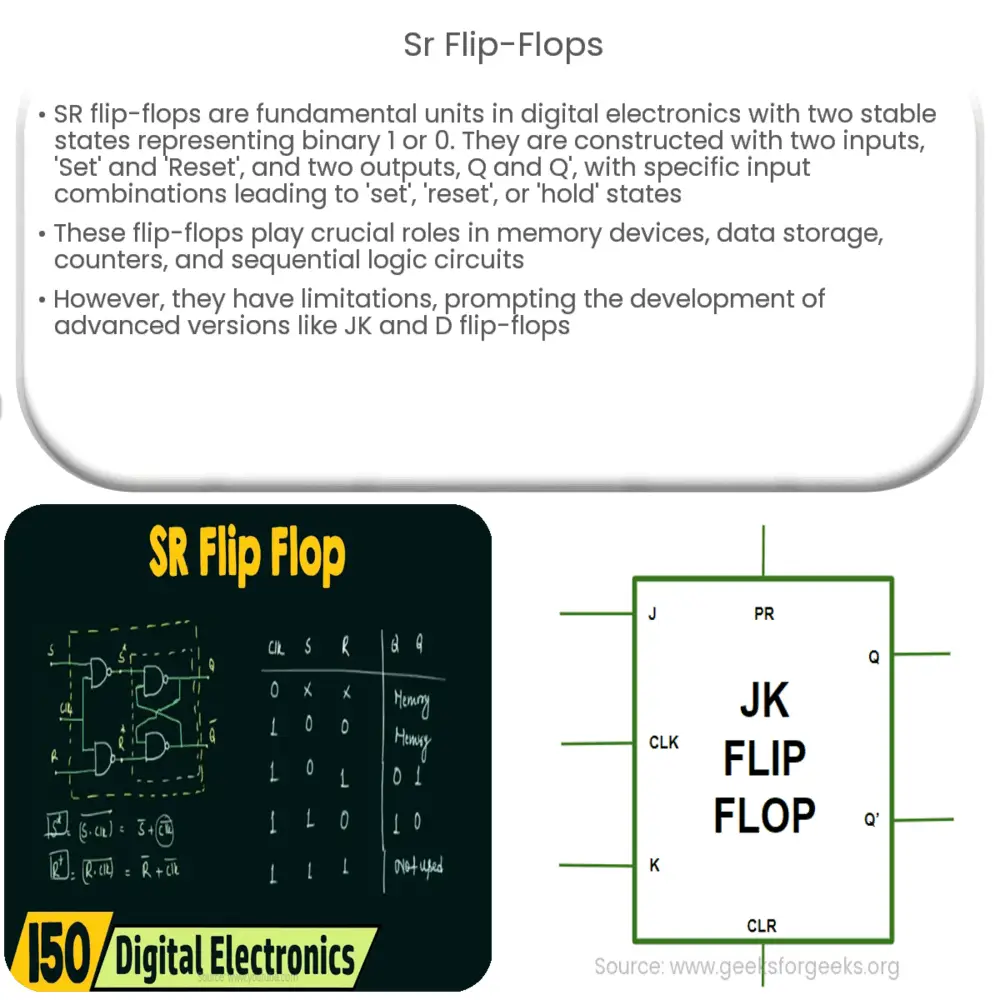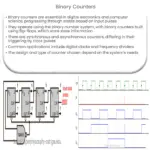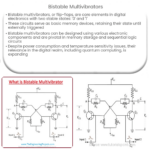Explore the essentials of SR Flip-Flops in digital electronics, their structure, operation, applications, limitations, and improvements.

Introduction to SR Flip-Flops
Flip-flops are fundamental building blocks of digital electronics systems used in computers, communications, and many other types of systems. One of the simplest types of flip-flops is the SR (Set-Reset) flip-flop. This basic bistable device has two stable states, representing a binary 1 or 0. It’s an essential component in many digital circuits because of its memory characteristic; it can retain one of its two states indefinitely.
The Structure of SR Flip-Flops
SR flip-flops are constructed with two inputs, ‘Set’ (S) and ‘Reset’ (R), and two outputs, Q and Q’. When a ‘1’ is applied to the ‘Set’ input and a ‘0’ to the ‘Reset’ input, the flip-flop ‘sets’ and Q=1, Q’=0. Conversely, when ‘Reset’ receives a ‘1’ and ‘Set’ a ‘0’, the flip-flop ‘resets’, with Q=0 and Q’=1. The states where both inputs are ‘1’ or ‘0’ are not typically used in SR flip-flops as they can lead to undefined or undesirable states.
The Basic Operation of SR Flip-Flops
- Set State: When the set input (S) is 1 and the reset input (R) is 0, the output Q goes to 1, which signifies the flip-flop is in the set state.
- Reset State: When the reset input (R) is 1 and the set input (S) is 0, the output Q goes to 0, signifying the flip-flop is in the reset state.
- Hold State: When both inputs S and R are 0, the flip-flop maintains its previous state, whether that was set or reset. This is known as the hold or memory state.
Applications of SR Flip-Flops
SR Flip-flops serve a vital role in many different types of digital electronics systems. They are used extensively in memory devices and data storage applications due to their ability to retain a binary state. This is particularly important for computer systems, where reliable data storage and retrieval is critical.
Besides, they are also used in counters and shift registers, allowing for the storage and shifting of binary data. In such applications, multiple flip-flops are connected in a chain, with the output of one flip-flop connected to the input of the next.
SR Flip-Flops in Sequential Logic Circuits
Sequential logic circuits, as opposed to combinational logic circuits, depend not only on the present inputs but also on past inputs. They utilize memory elements like flip-flops to remember past data. The SR flip-flop is a primary example of a memory element in sequential logic circuits. By capturing and storing binary values, SR flip-flops contribute significantly to the operation of sequential logic systems.
The Limitations of SR Flip-Flops
While SR flip-flops are remarkably useful devices, they also have certain limitations. The primary limitation is the undefined or unpredictable state when both the Set and Reset inputs are active (i.e., when both are 1). This condition is generally avoided in practical applications as it can lead to an unstable output, disrupting the functionality of the circuit.
Improvements to the Basic SR Flip-Flop
To counter the limitations of basic SR flip-flops, enhanced versions like the JK flip-flop and D flip-flop have been developed. JK flip-flops eliminate the undefined state by including a feature where both inputs can be 1 simultaneously, resulting in a toggle of the output state. D flip-flops, on the other hand, only have one input besides the clock input, simplifying the overall function and eliminating any undefined states.
Conclusion
In conclusion, SR flip-flops are vital components in digital electronic systems, playing a critical role in data storage and sequential logic circuits. Their ability to retain a binary state makes them indispensable in a wide array of applications, ranging from computer memory to shift registers. Despite their limitations, the basic principles of SR flip-flops have inspired the creation of more complex and reliable flip-flops, further advancing the field of digital electronics.
Understanding SR flip-flops, their operations, and their limitations provides a solid foundation for exploring more intricate and complex digital electronics concepts. As the digital world continues to expand and evolve, the principles embodied in these simple devices remain central to the operation of many digital systems.




